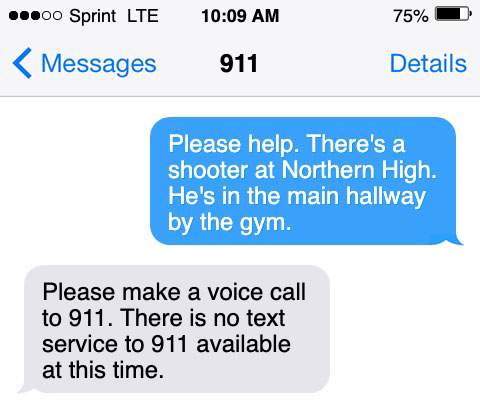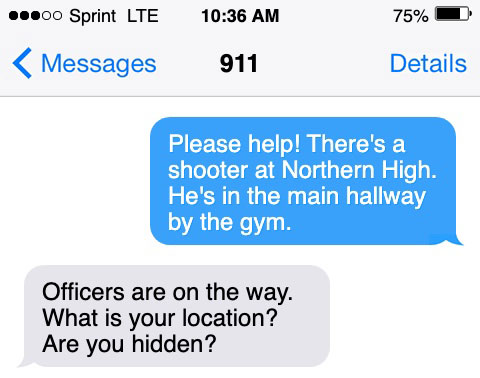Imagine this: You are 14 years old, hiding under a table in the school library, listening to distant gunshots. You hear the shooter in the hallway nearby and realize the perpetrator is getting closer.
Quietly, you send a text message to 911: “Please help. There’s a shooter at Northern High. He’s in the main hallway by the gym.” You then receive the following message back:

During an active shooter situation, exchanging information between teachers, students and public safety responders is critical for saving lives. Text-to-911, the ability to send SMS text messages directly to a 911 dispatch center, is one of the best tools available for this critical information exchange.
Advantages of Text-to-911
Hearing- and speech-impaired citizens have been advocating for Text-to-911 for years. Many have given up their landline-based communications devices for cellphones. For these people, Text-to-911 may be the only way to access public safety services. Text-to-911 also works well for those callers in rural areas on the edge of a cellular network. Text messages can often get through, even when there is not enough wireless connectivity for a voice call.
When the person in trouble needs to remain quiet, such as in domestic violence situations or the school shooter example above, Text-to-911 can make the difference between being able to take the risk of reaching out for help or not.
Depending on the size of the 911 center, also known as a Public Safety Answering Point (PSAP), even minor emergencies can quickly tie up the phone lines and prevent callers from getting through. Text-to-911 messages are delivered on a data network that does not require a 911 phone line to be available. Text-to-911 is also more efficient, as dispatchers can have multiple text sessions open at the same time on their workstations.
Text-to-911 Challenges
In 2009, Black Hawk County, Iowa, was the first PSAP to implement Text-to-911. In the ten years since, only about one-third of the PSAPs in the United States have moved forward with this lifesaving technology.
Implementing Text-to-911 is not easy. To begin the process, the public safety jurisdiction must formally request Text-to-911 from all the cellphone carriers in the jurisdiction. Circuits are then installed between the wireless carrier networks and a Text Control Center (TCC), which aggregates text messages from the wireless carriers and delivers them to the PSAP.
Text-to-911 also requires full-time monitoring by dispatchers. When an emergency text is sent, it is forwarded to the TCC, and then into the PSAP. At that point, 911 dispatchers have a two-way text dialog with the reporting party.
Implementing Text-to-911 requires a lot of paperwork. There are state, local and Federal readiness forms. Most wireless carriers require Text-to-911 Request for Service (RFS) letters from each 911 jurisdiction. This can turn into a paperwork nightmare for busy PSAP managers.
The functional and economic disparities between small and large 911 centers also play a role. Larger PSAPs have more technical staff and bigger budgets, whereas small PSAPs have a much tougher time supporting new technologies.
Text-to-911 is most easily implemented in large urban centers, but there are rural states, like Montana and Idaho, that have almost 100% Text-to-911 coverage. There are also, unfortunately, several states with absolutely no Text-to-911 coverage.
Another challenge to Text-to-911 implementation is 911 dispatchers are already overwhelmed. In small PSAPs, there might only be one dispatcher on duty at any given moment. PSAP workstations are often usually crowded with public safety applications and many centers don’t have room for another technology. Emergency text messages can also take longer for dispatchers to process, as most will keep a Text-to-911 session connected until responders arrive.
Some PSAPs have older 911 dispatchers who do not like text messaging. For these dispatchers, there is an inherent resistance towards Text-to-911, as they fear being bombarded with frivolous text messages or baffled by abbreviations and Emojis. Some wireless carriers allow pictures to be sent into Text-to-911, and many 911 dispatchers cringe at the thought of being sent potentially graphic or disturbing images.
Many PSAPs are waiting on Next-Generation 911 (NG911) — an Internet Protocol (IP) solution that will replace traditional phone lines in the PSAP — to bring them Text-to-911.
However, NG911 has been elusive, and although many states are working towards NG911, only a handful of PSAPs around the country have actually implemented NG911. Industry professionals agree it may take many years before all the PSAPs in the U.S. can make the switch.
Next Steps
Text-to-911 is an invaluable public safety service. With the right hardware and software upgrades, Text-to-911 can be integrated into most 911 call-taking systems. For all others, there are Internet-based Text-to-911 solutions that do not require equipment upgrades and have no recurring costs.
The Federal Communications Commission (FCC) maintains a registry that lists all PSAPs that have implemented Text-to-911. Additionally, school administrators, interested parents and concerned readers can inquire with their local police department or sheriff’s office to see if Text-to-911 has been implemented in their jurisdiction.
Some jurisdictions have coordinated Text-to-911 training exercises with schools and public safety responders. School officials are encouraged to work with law enforcement to get detailed procedures in place so students and teachers can utilize Text-to-911 to relay information during an active shooter event, fire or other emergency.
Text-to-911 saves lives. And back to the beginning of the article, if it was you hiding under that desk, or even your child, imagine the relief and renewed hope you would feel to receive this message back:

Ryan Olson is the owner and senior consultant for Third Signal, LLC, a public safety consulting company based in Missoula, Montana. You can contact Ryan at [email protected].







